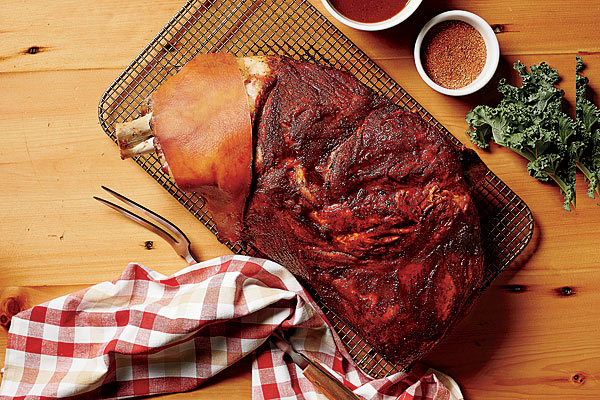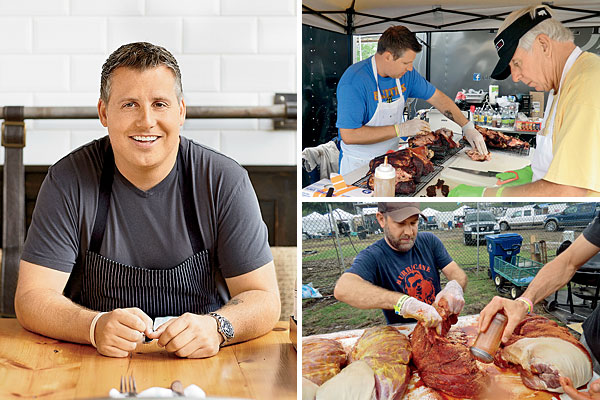
Photo: Anna Knott; Styling: Diane Ewing
The caravan of 250 makeshift cooking encampments that compose the 36th annual Memphis in May World Championship Barbecue Cooking Contest have created a haze of sweet smoke that lingers on the sweaty banks of the Mississippi. The rain has turned the grounds into a mile-long swath of muddy slop. Considering what’s on the menu, the conditions are perfect.
Behind his stainless steel trailer, Charlie McKenna, chef-owner of the Bucktown barbecue joint Lillie’s Q, presides over a table on which 180 pounds of heritage Duroc hogs are splayed. Knife in hand, wearing a cartoon pig T-shirt and flip-flops, the boyish 36-year-old removes the glossy fat cap from 10 gorgeous bone-in whole pork shoulders—the well-marbled cut cherished by pit masters—leaving a small section of skin around the collar.
When these 18-pound beauties emerge after 18 to 21 hours in the smoker, that excess flap will shine candy-apple red, lending each shoulder what McKenna calls a “two-tone ’57 Chevy look.” Removing most of the fat cap also reduces the grease content of the meat, which will be shredded into pulled pork. The technique is one of many the Lillie’s Q team employs to win over the judges, who score each entry on taste, tenderness, and appearance. “Some people think fat equals flavor,” McKenna says. “But you can have too much of a good thing.”
Most in attendance at the world’s biggest pork barbecue contest—the 36th annual Super Bowl of Swine—beg to differ. Strolling down the winding pathways, you see anthropomorphic pig statues dressed as Elvis, floating papier-mâché pigs sporting Viking helmets, banners touting saucy team names like the Count Bastie Porkestra. Several contestants have multilevel booths with stripper poles and dance floors, where women in cowboy boots cavort with heavyset men in sauce-stained aprons.
Despite the atmosphere, competition at Memphis in May is intense. This year’s event boasts a $110,000 purse, but most of the 250 teams say they’re more interested in the glory of winning top prize in one of the three majors: shoulder, ribs, and whole hog. Of those three finalists, only one earns the title of grand champion.
McKenna spent years saving for his $80,000 kitchen on wheels, pimped out with three smokers, a state-of-the-art ventilation system, a 50-inch flat screen, and a bar. Even with the advanced equipment and 12 years’ experience at contests, Lillie’s Q is a relative upstart. Next door, Big Bob Gibson BBQ, a legendary restaurant from Decatur, Alabama, dedicates an entire section of its booth to its trophies.
Lillie’s Q took the shoulder title here in 2007 and placed in the top 10 for five years straight, but it finished 24th last year. One key team member wasn’t in Memphis during that worst showing: McKenna’s father, Quito, 65, a retired air force colonel who collapsed from a cardiac arrhythmia days before the event. “It wasn’t a good day,” Quito deadpans as he paces the dusty walk in front of the trailer, trading quips with everyone who walks by.
The elder McKenna’s primary role is to serve as “the mouth.” His gift of gab comes in handy, because Memphis in May features both blind and onsite judging, where teams plead their cases to three certified meat arbiters. But Quito, who sports a pig-shaped belt buckle and a black Lillie’s Q visor over a shock of silver hair, also brings serious barbecue bona fides. The longtime backyard griller has been competing for well over a decade and spent years representing the kitchen equipment giant Viking at contests, where he was quickly lured into this cult of the open flame. “It gets in your blood,” Quito says of the barbecue circuit, which features heated rivalries, big egos (one pit master I meet casually compares his team’s dominance to that of Michael Jordan’s Bulls), and no shortage of intrigue.

Photography: (clockwise from left) Anna Knott; Courtesy of Rod O’Connor
Clockwise from left: Charlie McKenna; McKenna and his dad, Quito; prepping a pork shoulder
Downing beers while their meat sizzles, teams chatter about illicit brining, closet-vegetarian judges, and other rumors. “Cheating happens more often than you would think,” Charlie tells me. “But it’s not worth it for me to win like that. Competing here is supposed to be about community, camaraderie, brotherhood.”
It’s Quito who paved the way for Charlie’s entry into this smoky subculture. He taught his son to barbecue on a grill outside their home in Greenville, South Carolina; he also convinced Charlie to ditch a fine-dining career (which included stints at Avenues and Tru) to launch Lillie’s Q in Chicago in 2010. “I pulled him over to the dark side,” laughs Quito, who opened the original Lillie’s Q in Destin, Florida, in 2008. (That side got a little too dark in March this year, when the water heater in the basement of the Bucktown Lillie’s Q caught fire and charred the kitchen and dining room. The shuttered restaurant reopened in June.)
Throughout the weekend, the other members of the Lillie’s Q squad—GM Brian Musinski and a rotating cast of close friends, including Andrew Carroll of Andersonville and Jon Shimp from Palatine—tease Charlie about his strict attention to fire safety. And they razz Quito mercilessly about eating doughnuts against the wishes of his cardiologist. But beneath the smack talk, it’s obvious everyone is bringing something extra to this year’s competition; it’s equally clear that cooking together is a long-cherished and congenial pursuit for this determined father and son.
Back at the prep area, the afternoon sun emerges. Country tunes from Merle Haggard and Charlie Daniels fill the air, which feels as thick as a double-cut pork chop. The shoulders have already received a quick brine with a salt and molasses concoction, and now they’re ready to be injected.
“Doping is legal in this competition,” jokes Tommy Graham, a no-nonsense guy with a buzzcut who, along with his unflappable wife, Mendy (a blond ob-gyn whose surgical skills serve her well), are regulars at the Lillie’s Q in Destin. They joined the crew three years ago. Brandishing a large pump, Tommy methodically fills the pork with a solution of apple juice and brown sugar, causing the soft flesh to firm up like the body of a toned athlete. Next comes a slathering of yellow mustard, which opens the pores of the meat, and a rub that contains paprika, brown sugar, garlic salt, and various secret ingredients.
“We’ve got 10 minutes,” Charlie yells.
It’s 3:30, and the pork needs to get into the unlit smoker, where a slow-building “cold smoke” will infuse peach-wood flavor deep inside the meat. Time is ticking away, so I grab a shaker and help coat the shoulders with spices until they’re a bright ruby-orange. I pick up one of the slabs, cradling it with the same care I’d use to transport my infant daughter, and hand it to Charlie. He’ll stay up until 5 a.m. monitoring the temperature, applying a vinegar-based “mop” every few hours to keep the meat moist, and removing the shoulders when they hit 197 degrees in the 225-degree smoker. A final apple jelly glaze and they’re done. “It’s a small window,” says Charlie of the cooking time. “If you pull them off too late, you’re going to struggle to make them taste good.”
The next morning is judgment day. The crew selects the juiciest bubblegum-pink chunks of meat for the blind-tasting box. Charlie uses scissors to snip the caramelized outer layer, known as bark, which he arranges neatly atop the meat. “We call that the candy,” he says, handing me a piece. The taste is as advertised: sugary sweet with a pleasant chewiness. Then he tears off an interior hunk. It melts in my mouth—and every other piece of pork I’ve ever tasted is instantly forgotten.
The three judges visit over the course of 45 minutes, each welcomed with a red carpet over the mud-spattered turf. After showing off the smoker, Quito sits down across the table to close the deal. In a ballsy move, he slowly pulls the bone from the center of the slab to, as he explains, “show you how tender this meat is, how it holds its shape and does not fall apart.”
Quito points to the beautiful red smoke ring. Finally, he pulls shreds from six different places within the shoulder, demonstrating how each piece delivers the same flavor profile and moisture content. The rest of the team stands at attention while the judges eat with their hands from fine white china. “The flavor of the meat is so good you don’t need any sauce,” Quito says, but offers a bowl of Lillie’s Q’s Smoky Sauce just in case.
A few hours later, a golf cart pulls up next door, and the Big Bob Gibson booth erupts. They’ve been named one of the three finalists. During the awards ceremony that evening, their pork shoulder will earn second place, and they’ll also win best vinegar sauce. A Memphis team called Sweet Swine o’ Mine will take top shoulder and grand champion.
In the morning, the Lillie’s Q team is crushed to find out that it placed 13th. I ask Charlie if he plans to tweak his recipe or approach.
“I won’t change a thing,” he says with defiance. “These competitions are something I do with my dad for fun. If we win, great; if we don’t, we’ll come back better and stronger and take it next year.”
Spoken like a guy who’s been burned but rose from the ashes to rebuild in three months flat.
NEXT: Charlie McKenna’s 8 Tips for Smoking at Home
(Even If You Don’t Own a Smoker) »
8 Tips for Smoking at Home (Even If You Don’t Own a Smoker)
from Charlie McKenna
1. Start with quality meat, and you should end up with a quality product. (I recommend The Butcher & Larder, 1026 N. Milwaukee Ave.)
2. Buy a Thermapen meat thermometer ($96, amazon.com) to check the internal temperature of your meat. Cheap ones lead to inferior results.
3. Put your meat in the smoker while it’s cold. If you wait until it’s hot, the pores seize up, and you won’t be able to get as much smoke flavor into it.
4. Do not ramp up or turn down the temperature of your smoker. This will lead to uneven smoking and meat that won’t taste optimal. Keep the temperature at a steady 225 degrees.
5. Sprinkle on your barbecue rub. Because it contains salt, rubbing it in will cut the meat’s surface and the juices will run out.
6. Don’t mess with your meat when it’s in the smoker. Smoking takes time (five hours for ribs, about two and half for chicken breasts and thighs, and an hour per pound for pork shoulder).
7. Crack open a beer and relax.
8. When your meat hits the desired internal temperature (150 degrees for chicken, 197 degrees for pork, 135 degrees for beef), remove it from the smoker and let it rest for 15 minutes. Then pull it.
RELATED: How to Smoke Ribs Out Back Like Charlie McKenna Does ’Em at Lillie’s Q »



